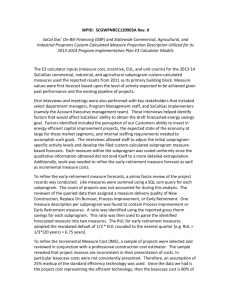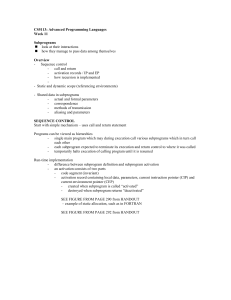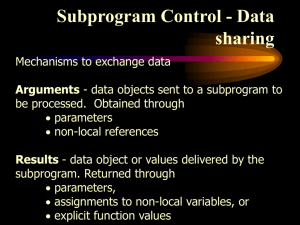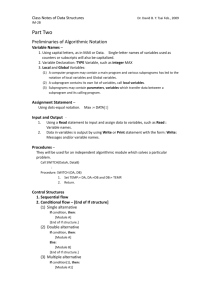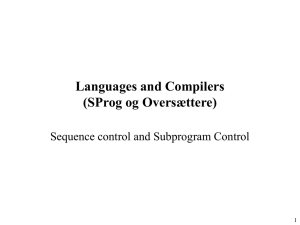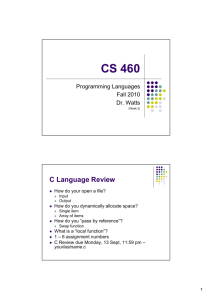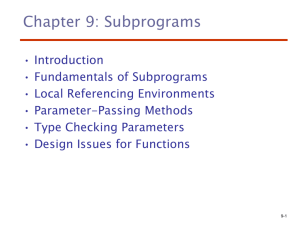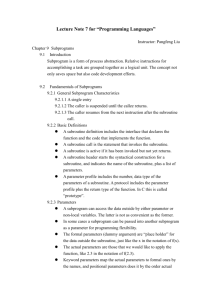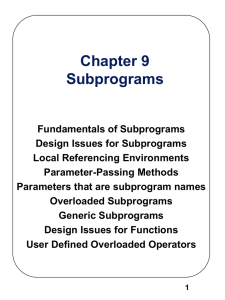Programming Language Concepts
advertisement
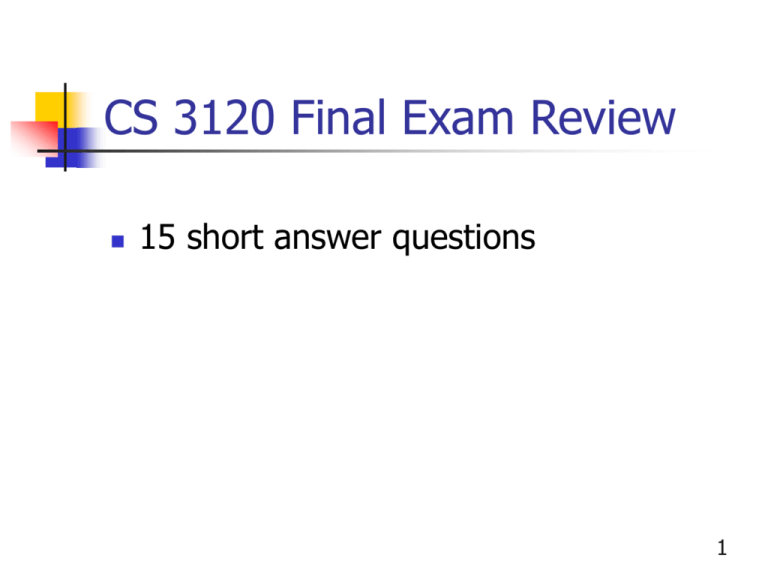
CS 3120 Final Exam Review
15 short answer questions
1
Programming Language
Concepts
Chapter 1: Preliminaries
Main Topics
Reasons for studying programming languages
Programming Domains
Language Evaluation Criteria
Influences on Language Design
Language Categories
Language Design Tradeoffs
Implementation Methods
Programming Environments
3
Why Study PLC?
Increased capacity to express ideas
Improved background for choosing
appropriate languages
Increased ability to learn new languages
Better understanding of the significance of
implementation
Increased ability to design new languages
Overall advancement of computing
4
Increased capacity to express ideas
Programming language constrains
Control structures
Data structures
Abstractions that can be used
Awareness of language features reduces
these limitations
Features of one language may be simulated in
another
Study of PLC builds appreciation for language
features and encourages their use
5
Language Evaluation Criteria
Readability
Writability
Reliability
Cost
6
Readability
Overall Simplicity
Control Statements
Data Types and Structures
Syntax Considerations
7
Writability
Support for abstraction
Process abstraction
Data abstraction
Expressivity
APL has powerful operators that accomplish lots of
computation with little coding
for statements for counting loops (instead of
while)
and then, or else Boolean operators in Ada
8
Reliability
Type checking
Exception handling
Subscript ranges: Ada vs. C
Static vs. dynamic type checking
Intercept runtime errors, take action to correct
problem, and continue processing
PL/I, C++, Ada, Java
Aliasing
2 or more ways to reference same memory cell
Possible via pointers, reference parameters,
unions
9
Costs
Training programmers
Writing programs
Compiling programs
Executing programs
Language implementation system
Poor reliability
Maintaining programs
10
Influences on Language Design
Computer architecture
Imperative languages model von Neumann
architecture
Functional programming languages need a nonvon Neumann architecture to be implemented
efficiently
Programming methodologies
Top-down design, stepwise refinement
Data-oriented vs. process-oriented design
Object-oriented design
Concurrency (process-oriented)
11
Language Categories
Imperative
Functional
Logic
Object-oriented
12
Language Design Tradeoffs
Reliability vs. cost of execution
Readability vs. writability
Ada’s runtime type checking adds to execution
overhead
C and APL
Flexibility vs. safety
Pascal variant record is a flexible way to view a
data object in different ways, but no type checking
is done to make it safe
13
Questions to Ponder
What are language design criteria?
What are some design trade-offs?
What are some language design
criteria that are in direct conflict
with each other?
14
Implementation methods
Compilation
Interpretation
Hybrid implementation systems
Java applets are compiled into byte code
Compiled applets are downloaded and
interpreted by byte code interpreter
15
Evolution of Major
Programming Languages
Chapter 2: Evolution Languages
Good chapter for background language
evolution information.
NOT on the final exam!
16
Lexical and Syntax Analysis
Chapter 3 and 4
Describing Syntax and Semantics
Lexical and Syntax Analysis
Definitions
Syntax: the form or structure of the
expressions, statements, and program units
Semantics: the meaning of the expressions,
statements, and program units
Sentence: a string of characters over some
alphabet
Language: a set of sentences
Lexeme: the lowest level syntactic unit of a
language (e.g., *, sum, begin)
Token: a category of lexemes (e.g., identifier)
18
Describing Syntax
Recognizers: used by compilers
A grammar is used to describe the
syntax of a language.
A context-free grammar can be used
to develop language translators.
19
Context-Free Grammar
A context-free grammar is one whose
productions take the form A ,
where A is a single non-terminal symbol
and is any string of terminals and/or
non-terminals.
Context-free grammars are used to
describe the syntax of modern
programming languages.
20
Derivation
A derivation is a repeated application of rules,
starting with the start symbol and ending
with a sentence. In each step of a derivation,
exactly one non-terminal is expanded.
Every string of symbols in a derivation is a
sentential form. A sentential form may
contain terminal and non-terminal symbols.
A sentence is a sentential form that has only
terminal symbols.
21
Parse Trees
Grammars describe the hierarchical
syntactic structure of sentences in the
language they define
These hierarchical structures are called
parse trees.
Every internal node is labeled with a nonterminal symbol
Every leaf is labeled with a terminal symbol
22
Questions to Ponder
What’s syntax and semantics?
What’s syntax analysis?
What’s lexical analysis?
What’s a lexeme and a token?
What are grammars used for?
No graphs or parse trees on the final!
23
Names, Bindings, Type
Checking, and Scopes
Chapter 5
Naming
Naming is the process by which the
programmer associates a name with a
potentially complicated program fragment
The goal is to hide complexity
Programming languages use name to designate
variables, types, classes, methods, operators,…
Naming provides abstraction
E.g. Mathematics is all about the formal notation
(i.e. naming) that lets us explore more and more
abstract concepts
25
Variable Names
Design issues
-
What should the maximum length be?
Are connector characters allowed?
Are names case sensitive?
Are special words reserved words or keywords?
Length
-
FORTRAN I: maximum 6
COBOL: maximum 30
FORTRAN 90 and ANSI C: maximum 31
Ada: no limit, and all are significant
C++: no limit, but implementers often impose one
26
Variable Names
Case sensitivity
Disadvantage: readability (names that look alike are different)
• C, C++, Java, and Modula-2 names are case sensitive
• The names in other languages are not
Special words
A keyword is a word that is special only in certain contexts
Disadvantage: poor readability
A reserved word is a special word that cannot be used as a userdefined name
27
Variable Names
A variable is an abstraction of a memory cell
Variables can be characterized as a collection of attributes:
name, address, value, type, lifetime, and scope
Name - not all variables have them
Address - the memory address with which it is associated
• A variable may have different addresses at different times
during execution
• A variable may have different addresses at different places
in a program
• If two variable names can be used to access the same
memory location, they are called aliases
28
Attributes of variables
Name—not all variables have a name
Address
The memory address with which a variable
is associated
A variable may have different addresses at
different times
Two names that can be used to access the
same memory location are called aliases
29
Attributes of variables
Type
Determines the range of values of variables
and the set of operations defined for those
values
Value
The contents of the location with which a
variable is associated
30
Some definitions
Binding—an association, such as
between an attribute and an entity, or
between an operation and a symbol
Binding time—the time at which a
binding takes place
31
Binding times
Compile time
Load time
Example: binding of a variable to a type in C
Example: binding of a C static variable to a
memory cell
Run time
Example: binding of a non-static local variable
to a memory cell
32
More on binding
A binding is static if it
occurs before run time and
remains unchanged throughout execution
A binding is dynamic if it
Occurs during execution, or
Can change during execution
33
Scope
The scope of a variable is the range of
statements over which it is visible
The non-local variables of a program unit are
those that are visible but not declared there
The scope rules of a language determine how
references to names are associated with
variables
Scope may be static or dynamic
34
Static scope
Based on the text of a program
To connect a name reference to a variable,
the compiler must find the declaration
Search process: search declarations, first locally,
then in increasingly larger enclosing scopes, until
one is found for the given name.
35
Dynamic scope
Based on calling sequences of program
units, not their textual layout
References to variables are connected to
declarations by searching back through the
chain of subprogram calls that forced
execution to this point
36
Scope vs. lifetime
Scope and lifetime are sometimes closely related,
but are different concepts.
Consider a static variable in a C or C++ function:
void fun() {
static int x = 0;
int y = 0;
…
}
Scope of x and y is from point of declaration to end of
function block
Lifetime of x is entire execution of program
Lifetime of y is during execution of fun()
37
Scope and Blocks
Blocks - a method of creating static scopes
inside program units. Example:
C and C++:
for (...) {
int index;
...
}
38
Variable initialization
The binding of a variable to a value at
the time it is bound to storage is called
initialization
Initialization is often done on the
declaration statement:
C++: float sum = 0.0;
39
Type Checking
Type checking is the activity of ensuring that the
operands of an operator are of compatible types
A compatible type is one that is either legal for the
operator, or is allowed under language rules to be
implicitly converted, by compiler-generated code, to a
legal type.
A type error is the application of an operator to an
operand of an inappropriate type
A programming language is strongly typed if type
errors are always detected
40
Strong Typing
Allows the detection of the misuses
of variables that result in type
errors.
C and C++ don’t have strong
typing: parameter type checking
can be avoided; unions are not type
checked (Java is similar)
41
Questions to Ponder
What are some design issues for names?
What is static and dynamic scoping?
What is type checking?
What’s strong typing?
42
Chapters 6 and 8
(no 7 on exam)
Data Types
Statement-Level Control Structures
Abstract Data Types
Abstract Data Type
- the use of type is separated from the
representation and operations on values
of that type
44
Ordinal Types ( user defined )
An ordinal type is one in which the range of
possible values can be easily associated
with the set of positive integers.
Enumeration Types
- one in which the user enumerates all of
the possible values, which are symbolic
constants
Design Issue:
Should a symbolic constant be allowed to
be in more than one type definition?
45
Arrays
• An array is an aggregate of homogeneous
data elements in which an individual element
is identified by its position in the aggregate,
relative to the first element.
Specific element of an array is identified by:
i) Aggregate name;
ii) Index (subscript):
position relative to the first element.
46
Design Issues for Arrays
1. What types are legal for subscripts?
2. Are subscripting expressions in
element references range checked?
3. When are subscript ranges bound?
4. When does allocation take place?
5. What is the maximum number of
subscripts?
6. Can array objects be initialized?
47
Pointers
A pointer type is a type in which the range of values
consists of memory addresses and a special value,
null. The value null indicates that a pointer cannot
currently be used to reference another object.
Design Issues:
1. What is the scope and lifetime of pointer variables?
2. What is the lifetime of heap-dynamic variables?
3. Are pointers restricted to pointing at a particular type?
4. Are pointers used for dynamic storage management, indirect
addressing, or both?
5. Should a language support pointer types, reference types, or
both?
48
Fundamental Pointer Operations
1. Assignment: Sets a pointer variable to the
address of some object.
2. References: Obtaining the value of the
memory cell whose address is in the memory
cell to which the pointer variable is bound to.
In C and C++, dereferencing is specified by
prefixing a identifier of a pointer type by the
dereferencing operator (*).
49
Problems with pointers
1. Dangling pointers (dangerous)
- A pointer points to a heap-dynamic variable that
has been de-allocated
2. Memory Leak (wasteful)
- A heap dynamic variable that is no longer
referenced by any program pointer
50
Levels of Control Flow
The flow of control, or execution sequence, in program can be
examined at several levels:
1. Within expressions
2. Among program units
3. Among program statements
Def: Statements that provide capabilities such as,
selecting among alternative control flow paths or
causing the repeated execution of certain collection
of statements are called control statements
Def: A control structure is a control statement and the
statements whose execution it controls
51
Classification of Control Statements
Selection statements: Choose between two or more
execution paths in a program.
Two-way selection statements:
Select one of two execution paths—if-then-else statements.
Design issues
What is the form and type of the expression that controls
the selection
Can a single statement, a sequence of statements, or a
compound statement be selected
How should the meaning of nested selectors be specified
52
Multiple selection constructs
Multiple selection construct allows the selection of one or
any number of statements or statement groups (switch
construct).
Design issues for multiple way selectors:
What is the type and form of expression that controls the selection?
May single statement, sequence of statements or compound
statement be selected?
Is the entire construct encapsulated in a syntactic structure?
Is execution flow through the structure restricted to include just one
selectable segment?
How should unrepresented selector expression values be handled, if at
all?
53
Iterative Statements
The repeated execution of a statement or compound
statement is accomplished either by iteration or
recursion.
General design Issues for iteration control statements:
1. How is iteration controlled?
2. Where is the control mechanism in the loop?
The primary possibilities for iteration control are
logical, counting or combination of this two. Main
choices for the location of the control mechanism are
top or bottom of the loop.( posttest, or pretest)
54
Questions to Ponder
What are some common data types?
What are some design issues associated
with arrays and pointers?
What are some design issues related to
control structures?
55
Chapter 9 – Subprograms
(No 10 or 11 on Final Exam)
Fundamentals of Subprograms
Design Issues for Subprograms
Subprogram Definitions
1. A subprogram has a single entry point
2. The caller is suspended during execution of the called subprogram
3. Control always returns to the caller when the called subprogram’s
execution terminates
A subprogram definition is a description of the actions of the subprogram
abstraction
A subprogram call is an explicit request that the subprogram be executed
A subprogram header is the first line of the definition, including the name,
the kind of subprogram, and the formal parameters
The parameter profile of a subprogram is the number, order, and types of
its parameters
57
Design Issues for Subprograms
1. What parameter passing methods are provided?
2. Are parameter types checked?
3. Are local variables static or dynamic?
4. What is the referencing environment of a passed
subprogram?
5. Are parameter types in passed subprograms
checked?
6. Can subprogram definitions be nested?
7. Can subprograms be overloaded?
8. Are subprograms allowed to be generic?
9. Is separate or independent compilation
supported?
58
Implementing Parameter Passing
Value or Name - copy it to the stack;
passes the identify for the parameter
Result – same
Reference - regardless of form, put the
address in the stack. Evaluate the
address of the parameter
59
Design Considerations for
Parameter Passing
1. Efficiency
2. One-way or two-way
- These two are in conflict with one another!
Good programming => limited access to
variables, which means one-way whenever
possible
Efficiency => pass by reference is fastest way to
pass structures of significant size
60
Parameters that are
Subprogram Names
1. Are parameter types checked?
2. What is the correct referencing environment
for a subprogram that was sent as a parameter?
- Possibilities:
a. It is that of the subprogram that enacts it.
- Shallow binding
b. It is that of the subprogram that declared it.
- Deep binding
61
Generic Subprograms
A generic or polymorphic subprogram is one that
takes parameters of different types on different
activations
Overloaded subprograms provide polymorphism
A subprogram that takes a generic parameter that
is used in a type expression that describes the
type of the parameters of the subprogram
provides parametric polymorphism
62
Functions
Design Issues:
1. Are side effects allowed?
2. What types of return values are allowed?
3. What should the variable access method be?
The non-local variables of a subprogram are those
that are visible but not declared in the subprogram
Global variables are those that may be visible in all
of the subprograms of a program
63
Questions to Ponder
What are some design issues for
subprograms?
What are some design issues for
parameter passing?
What is polymorphism?
What are some design issues for
functions?
64
Chapter 12, 15, 16
Object-Oriented, Functional and
Logical Programming Languages
Object-Oriented Languages
Abstract Data Types are called classes
Class instances are called objects
A class that inherits is a derived class or a subclass
The class from which another class inherits is a parent
class or superclass
Subprograms that define operations on objects are
called methods
In the simplest case, a class inherits all of the entities of
its parent
66
Pure Functional Languages
The concept of assignment is not part of functional
programming
1.
2.
3.
4.
no explicit assignment statements
variables bound to values only through parameter binding at
functional calls
function calls have no side-effects
no global state
Control flow: functional calls and conditional
expressions
no iteration!
repetition through recursion
67
FPLs vs imperative languages
Imperative programming languages
Design is based directly on the von Neumann architecture
Efficiency is the primary concern, rather than the suitability
of the language for software development
Functional programming languages
The design of the functional languages is based on
mathematical functions
A solid theoretical basis that is also closer to the user, but
relatively unconcerned with the architecture of the machines
on which programs will run
68
Lambda expressions
A mathematical function is a mapping of members of
one set, called the domain set, to another set, called
the range set
A lambda expression specifies the parameter(s)
and the mapping of a function in the following form
(x) x * x * x
for the function
cube (x) = x * x * x
Lambda expressions describe nameless functions
69
Fundamentals of FPLs
The objective of the design of a FPL is to mimic
mathematical functions as much as possible
The basic process of computation is fundamentally
different in a FPL than in an imperative language:
In an imperative language, operations are done and the
results are stored in variables for later use
Management of variables is a constant concern and source
of complexity for imperative programming languages
In an FPL, variables are not necessary, as is the case in
mathematics
The evaluation of a function always produces the
same result given the same parameters. This is
called referential transparency
70
LISP
Functional language developed in the mid 50’s
Semantics based on the lambda-calculus
All functions operate on lists or symbols (called Sexpressions)
Only 6 basic functions
list functions: cons, car, cdr, equal, atom
conditional construct: cond
Useful for list processing
Useful for Artificial Intelligence applications:
programs can read and generate other programs
71
Scheme
A mid-1970s dialect of LISP, designed to
be a cleaner, more modern, and simpler
version than the contemporary dialects
of LISP
Functions are first-class entities
They can be the values of expressions and
elements of lists
They can be assigned to variables and
passed as parameters
72
Prolog
PROgramming in LOGic
It is the most widely used logic
programming language
Its development started in 1970
What’s it good for?
Knowledge representation
Natural language processing
State-space searching (Rubik’s cube)
Expert systems, deductive databases, Agents
73
Overview of
Logic Programming
Main idea: Ask the computer to solve
problems using principles of logic:
Program states the known facts
To ask a question, you make a statement
and ask the computer to search for a proof
that the statement is true
Additional mechanisms are provided to
guide the search to find a proof
74
Declarative vs. Imperative
Languages used for logic programming are called
declarative languages because programs written in
them consist of declarations rather than assignment
and flow-of-control statements. These declarations
are statements, or propositions, in symbolic logic.
Programming in imperative languages (e.g., Pascal,
C) and functional languages (e.g., Lisp) is procedural,
which means that the programmer knows what is to
be accomplished by the program and instructs the
computer on exactly how the computation is to be
done.
75
Logic Programming
Programming in logic programming languages
is non-procedural.
Programs in such languages do not state how
a result is to be computed. Instead, we
supply the computer with:
relevant information (facts and rules)
a method of inference for computing desired
results.
Logic programming is based on the predicate
calculus.
76
Questions to Ponder
What are some characteristics of
Object-Oriented, Functional and Logical
Programming Languages?
What’s the difference between
Declarative and Imperative
Programming Languages?
77
End of Final Exam Review
• 15 short answer questions
• Good luck!
78
